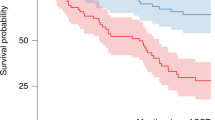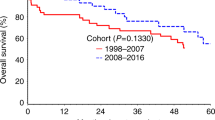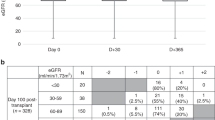Abstract
Renal dysfunction is a common complication of plasma cell myeloma (PCM) that may be severe enough to necessitate hemodialysis. Although high-dose chemotherapy and hematopoietic cell transplant (HCT) appears superior to conventional chemotherapy in likelihood of achieving CR and is associated with improvement in and, at times, reversal of renal dysfunction, many patients remain dialysis-dependent presenting the challenge of renal transplantation in this population. We reviewed the published literature and summarize the outcomes on dual organ (HCT and renal allograft) transplantation in patients with PCM and dialysis-dependent renal failure. In a literature review of 14 reports, 26 of 166 dialysis-dependent patients became dialysis-independent. Our review includes a very heterogenous patient population but suggests that HCT and renal allograft may be feasible in a subset of PCM patients with dialysis-dependent renal failure. Although there is a concern for renal allograft rejection upon withdrawal of immunosuppression, data suggest that resumption of antirejection therapy leads to stable renal function. Bortezomib potentially can be used as maintenance treatment in patients who have not achieved a CR while preventing renal allograft rejection. The literature that describes dual transplants has included patients with long-term follow-up (>7 years in some patients). It is possible, however, that there may be publication bias with only favorable results being reported. More research is necessary to further delineate the subset of PCM patients most likely to benefit from renal transplant. A special registry for data collection for long-term follow-up may be useful to improve future patient survival.
This is a preview of subscription content, access via your institution
Access options
Subscribe to this journal
Receive 12 print issues and online access
$259.00 per year
only $21.58 per issue
Buy this article
- Purchase on Springer Link
- Instant access to full article PDF
Prices may be subject to local taxes which are calculated during checkout
Similar content being viewed by others
References
Kyle RA . Multiple myeloma: review of 869 cases. Mayo Clin Proc 1975; 50: 29–40.
Rebibou JM, Caillot D, Casasnovas RO, Tanter Y, Maillard N, Solary E et al. Peripheral blood stem cell transplantation in a multiple myeloma patient with end-stage renal failure. Bone Marrow Transplant 1997; 20: 63–65.
Badros A, Barlogie B, Siegel E, Roberts J, Langmaid C, Zangari M et al. Results of autologous stem cell transplant in multiple myeloma patients with renal failure. Br J Haematol 2001; 114: 822–829.
DeFronzo RA, Cooke CR, Wright JR, Humphrey RL . Renal function in patients with multiple myeloma. Medicine (Baltimore) 1978; 57: 151–166.
Torra R, Blade J, Cases A, Lopez-Pedret J, Montserrat E, Rozman C et al. Patients with multiple myeloma requiring long-term dialysis: presenting features, response to therapy, and outcome in a series of 20 cases. Br J Haematol 1995; 91: 854–859.
Johnson WJ, Kyle RA, Pineda AA, O'Brien PC, Holley KE . Treatment of renal failure associated with multiple myeloma. Plasmapheresis, hemodialysis, and chemotherapy. Arch Intern Med 1990; 150: 863–869.
Knudsen LM, Hjorth M, Hippe E . Renal failure in multiple myeloma: reversibility and impact on the prognosis. Nordic Myeloma Study Group. Eur J Haematol 2000; 65: 175–181.
Alexanian R, Barlogie B, Dixon D . Renal failure in multiple myeloma. Pathogenesis and prognostic implications. Arch Intern Med 1990; 150: 1693–1695.
Blade J, Fernandez-Llama P, Bosch F, Montoliu J, Lens XM, Montoto S et al. Renal failure in multiple myeloma: presenting features and predictors of outcome in 94 patients from a single institution. Arch Intern Med 1998; 158: 1889–1893.
Cohen DJ, Sherman WH, Osserman EF, Appel GB . Acute renal failure in patients with multiple myeloma. Am J Med 1984; 76: 247–256.
Cosio FG, Pence TV, Shapiro FL, Kjellstrand CM . Severe renal failure in multiple myeloma. Clin. Nephrol 1981; 15: 206–210.
Korzets A, Tam F, Russell G, Feehally J, Walls J . The role of continuous ambulatory peritoneal dialysis in end-stage renal failure due to multiple myeloma. Am J Kidney Dis 1990; 16: 216–223.
Attal M, Harousseau JL, Stoppa AM, Sotto JJ, Fuzibet JG, Rossi JF et al. A prospective, randomized trial of autologous bone marrow transplantation and chemotherapy in multiple myeloma. Intergroupe Francais du Myelome. N Engl J Med 1996; 335: 91–97.
Barlogie B, Jagannath S, Desikan KR, Mattox S, Vesole D, Siegel D et al. Total therapy with tandem transplants for newly diagnosed multiple myeloma. Blood 1999; 93: 55–65.
Bird JM, Fuge R, Sirohi B, Apperley JF, Hunter A, Snowden J et al. The clinical outcome and toxicity of high-dose chemotherapy and autologous stem cell transplantation in patients with myeloma or amyloid and severe renal impairment: a British Society of Blood and Marrow Transplantation study. Br J Haematol 2006; 134: 385–390.
Parikh GC, Amjad AI, Saliba RM, Kazmi SM, Khan ZU, Lahoti A et al. Autologous hematopoietic stem cell transplantation may reverse renal failure in patients with multiple myeloma. Biol Blood Marrow Transplant 2009; 15: 812–816.
Reiter E, Kalhs P, Keil F, Rabitsch W, Gisslinger H, Mayer G et al. Effect of high-dose melphalan and peripheral blood stem cell transplantation on renal function in patients with multiple myeloma and renal insufficiency: a case report and review of the literature. Ann Hematol 1999; 78: 189–191.
Lee CK, Zangari M, Barlogie B, Fassas A, van Rhee F, Thertulien R et al. Dialysis-dependent renalfailure in patients with myeloma can be reversed by high-dose myeloablative therapy and autotransplant. Bone Marrow Transplant 2004; 33: 823–828.
Tauro S, Clark FJ, Duncan N, Lipkin G, Richards N, Mahendra P . Recovery of renal function after autologous stem cell transplantation in myeloma patients with end-stage renal failure. Bone Marrow Transplant 2002; 30: 471–473.
Sorof JM, Koerper MA, Portale AA, Potter D, DeSantes K, Cowan M . Renal transplantation without chronic immunosuppression after T cell-depleted, HLA-mismatched bone marrow transplantation. Transplantation 1995; 59: 1633–1635.
Jacobsen N, Taaning E, Ladefoged J, Kristensen JK, Pedersen FK . Tolerance to an HLA-B,DR disparate kidney allograft after bone-marrow transplantation from same donor. Lancet 1994; 343: 800.
Sayegh MH, Fine NA, Smith JL, Rennke HG, Milford EL, Tilney NL . Immunologic tolerance to renal allografts after bone marrow transplants from the same donors. Ann Intern Med 1991; 114: 954–955.
Butcher JA, Hariharan S, Adams MB, Johnson CP, Roza AM, Cohen EP . Renal transplantation for end-stage renal disease following bone marrow transplantation: a report of six cases, with and without immunosuppression. Clin Transplant 1999; 13: 330–335.
Helg C, Chapuis B, Bolle J, Morel P, Salomon D, Boux E, Antonioli V et al. Renal transplantation without immunosuppression in a host with tolerance induced by allogeneic bone marrow transplantation. Transplantation 1994; 58: 1420–1421.
Sellers MTDM, Curtis JJ, Gaston RS, Julian BA, Lanier DC, Diethelm AG . Tolerance in renal transplantation after allogeneic bone marrow transplantation-6-year follow up. Transplantation 2001; 71: 1681–1683.
Gajewski JL, Ippoliti C, Ma Y, Champlin R . Discontinuation of immunosuppression for prevention of kidney graft rejection after receiving a bone marrow transplant from the same HLA identical sibling donor. Am J Hematol 2002; 71: 311–313.
Beitinjaneh A, Burns LJ, Majhail NS . Solid organ transplantation in survivors of hematopoietic cell transplantation: a single institution case series and literature review. Clin Transplant 24: E94–E102.
Hamawi K, De Magalhaes-Silverman M, Bertolatus JA . Outcomes of renal transplantation following bone marrow transplantation. Am J Transplant 2003; 3: 301–305.
Leung N, Griffin MD, Dispenzieri A, Haugen EN, Gloor JM, Schwab TR et al. Living donor kidney and autologous stem cell transplantation for primary systemic amyloidosis (AL) with predominant renal involvement. Am J Transplant 2005; 5: 1660–1670.
Rego F, Alcantara P, Buinho F, Araujo F, Santos JM, Parreira A et al. Autologous peripheral stem cell transplantation for multiple myeloma in a patient with a 10 year-old kidney transplant: case report and clinical issues. Transplant Proc 2003; 35: 1102–1104.
Beatty PG . The immunogenetics of bone marrow transplantation. Transfus Med Rev 1994; 8: 45–58.
Szydlo R, Goldman JM, Klein JP, Gale RP, Ash RC, Bach FH et al. Results of allogeneic bone marrow transplants for leukemia using donors other than HLA-identical siblings. J Clin Oncol 1997; 15: 1767–1777.
Mayumi H, Umesue M, Nomoto K . Cyclophosphamide-induced immunological tolerance: an overview. Immunobiology 1996; 195: 129–139.
Luznik L, O'Donnell PV, Symons HJ, Chen AR, Leffell MS, Zahurak M et al. HLA-haploidentical bone marrow transplantation for hematologic malignancies using nonmyeloablative conditioning and high-dose, posttransplantation cyclophosphamide. Biol Blood Marrow Transplant 2008; 14: 641–650.
Kawai T, Cosimi AB, Spitzer TR, Tolkoff-Rubin N, Suthanthiran M, Saidman SL et al. HLA-mismatched renal transplantation without maintenance immunosuppression. N Engl J Med 2008; 358: 353–361.
Sharabi Y, Sachs DH . Mixed chimerism and permanent specific transplantation tolerance induced by a nonlethal preparative regimen. J Exp Med 1989; 169: 493–502.
Fuchimoto Y, Huang CA, Yamada K, Shimizu A, Kitamura H, Colvin RB et al. Mixed chimerism and tolerance without whole body irradiation in a large animal model. J Clin Invest 2000; 105: 1779–1789.
Kawai TCA, Colvin RB, Powelson J, Eason J, Kozlowski T, Sykes M et al. Mixed allogeneic chimerism and renal allograft tolerance in cynomolgus monkeys. Transplantation 1995; 59: 256–262.
Kawai T, Poncelet A, Sachs DH, Mauiyyedi S, Boskovic S, Wee SL et al. Long-term outcome and alloantibody production in a non-myeloablative regimen for induction of renal allograft tolerance. Transplantation 1999; 68: 1767–1775.
Kawai T, Sogawa H, Boskovic S, Abrahamian G, Smith RN, Wee SL et al. CD154 blockade for induction of mixed chimerism and prolonged renal allograft survival in nonhuman primates. Am J Transplant 2004; 4: 1391–1398.
Kimikawa M, Kawai T, Sachs DH, Colvin RB, Bartholomew A, Cosimi AB . Mixed chimerism and transplantation tolerance induced by a nonlethal preparative regimen in cynomolgus monkeys. Transplant Proc 1997; 29: 1218.
Mezrich JD, Yamada K, Lee RS, Mawulawde K, Benjamin LC, Schwarze ML et al. Induction of tolerance to heart transplants by simultaneous cotransplantation of donor kidneys may depend on a radiation-sensitive renal-cell population. Transplantation 2003; 76: 625–631.
Fudaba Y, Spitzer TR, Shaffer J, Kawai T, Fehr T, Delmonico F et al. Myeloma responses and tolerance following combined kidney and nonmyeloablative marrow transplantation: in vivo and in vitro analyses. Am J Transplant 2006; 6: 2121–2133.
Spitzer TR, Sykes M, Tolkoff-Rubin N, Kawai T, McAfee SL, Dey BR et al. Long-term follow-up of recipients of combined human leukocyte antigen-matched bone marrow and kidney transplantation for multiple myeloma with end-stage renal disease. Transplantation 2011; 91: 672–676.
US Renal Data System UADR. Atlas of chronic kidney disease and end-stage renal disease in the United States. National Institutes of Health, National Institure of Diabetes and Digestive and Kidney Diseases: Bethesda, MD, 2009.
Tyan DB, Li VA, Czer L, Trento A, Jordan SC . Intravenous immunoglobulin suppression of HLA alloantibody in highly sensitized transplant candidates and transplantation with a histoincompatible organ. Transplantation 1994; 57: 553–562.
Montgomery RA, Zachary AA, Racusen LC, Leffell MS, King KE, Burdick J et al. Plasmapheresis and intravenous immune globulin provides effective rescue therapy for refractory humoral rejection and allows kidneys to be successfully transplanted into cross-match-positive recipients. Transplantation 2000; 70: 887–895.
Stegall MD, Gloor JM . Deciphering antibody-mediated rejection: new insights into mechanisms and treatment. Curr Opin Organ Transplant 15: 8–10.
Terasaki PI . Humoral theory of transplantation. Am J Transplant 2003; 3: 665–673.
Adrogue HE, Soltero L, Land GA, Ramanathan V, Truong LD, Suki WN . Immunoglobulin therapy for plasma cell-rich rejection in the renal allograft. Transplantation 2006; 82: 567–569.
San Miguel JF, Schlag R, Khuageva NK, Dimopoulos MA, Shpilberg O, Kropff M et al. Bortezomib plus melphalan and prednisone for initial treatment of multiple myeloma. N Engl J Med 2008; 359: 906–917.
Ballester OF, Tummala R, Janssen WE, Fields KK, Hiemenz JW, Goldstein SC et al. High-dose chemotherapy and autologous peripheral blood stem cell transplantation in patients with multiple myeloma and renal insufficiency. Bone Marrow Transplant 1997; 20: 653–656.
Royer B, Arnulf B, Martinez F, Roy L, Flageul B, Etienne I et al. High dose chemotherapy in light chain or light and heavy chain deposition disease. Kidney Int 2004; 65: 642–648.
Carlson K . Melphalan 200 mg/m2 with blood stem cell support as first-line myeloma therapy: impact of glomerular filtration rate on engraftment, transplantation-related toxicity and survival. Bone Marrow Transplant 2005; 35: 985–990.
Hassoun H, Flombaum C, D'Agati VD, Rafferty BT, Cohen A, Klimek VM et al. High-dose melphalan and auto-SCT in patients with monoclonal Ig deposition disease. Bone Marrow Transplant 2008; 42: 405–412.
Raab MS, Breitkreutz I, Hundemer M, Benner A, Klaus J, Hegenbart U et al. The outcome of autologous stem cell transplantation in patients with plasma cell disorders and dialysis-dependent renal failure. Haematologica 2006; 91: 1555–1558.
Gertz MA, Lacy MQ, Dispenzieri A, Hayman SR, Kumar S, Leung N et al. Impact of age and serum creatinine value on outcome after autologous blood stem cell transplantation for patients with multiple myeloma. Bone Marrow Transplant 2007; 39: 605–611.
Tosi P, Zamagni E, Ronconi S, Benni M, Motta MR, Rizzi S et al. Safety of autologous hematopoietic stem cell transplantation in patients with multiple myeloma and chronic renal failure. Leukemia 2000; 14: 1310–1313.
Khoriaty R, Otrock ZK, Medawar WA, Khauli RB, Bazarbachi A . A case of successful double sequential bone marrow and kidney transplantations in a patient with multiple myeloma. Nephrol Dial Transplant 2006; 21: 3585–3588.
Author information
Authors and Affiliations
Corresponding author
Ethics declarations
Competing interests
The authors declares no conflict of interest
Rights and permissions
About this article
Cite this article
Nayak, L., Lazarus, H. Renal allografts in plasma cell myeloma hematopoietic cell graft recipients: on the verge of an explosion?. Bone Marrow Transplant 48, 338–345 (2013). https://doi.org/10.1038/bmt.2012.111
Received:
Revised:
Accepted:
Published:
Issue Date:
DOI: https://doi.org/10.1038/bmt.2012.111
Keywords
This article is cited by
-
Treatment of myeloma patients with renal impairment
memo - Magazine of European Medical Oncology (2015)



